Medscape CME Activity
Medscape, LLC is pleased to provide online continuing medical education (CME) for selected journal articles, allowing clinicians the opportunity to earn CME credit. In support of improving patient care, these activities have been planned and implemented by Medscape, LLC and Emerging Infectious Diseases. Medscape, LLC is jointly accredited by the Accreditation Council for Continuing Medical Education (ACCME), the Accreditation Council for Pharmacy Education (ACPE), and the American Nurses Credentialing Center (ANCC), to provide continuing education for the healthcare team.
CME credit is available for one year after publication.
Volume 22—2016
Volume 22, Number 12—December 2016
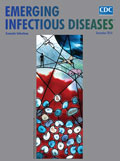
In August 2015, plague was diagnosed for 2 persons who had visited Yosemite National Park in California, USA. One case was septicemic and the other bubonic. Subsequent environmental investigation identified probable locations of exposure for each patient and evidence of epizootic plague in other areas of the park. Transmission of Yersinia pestis was detected by testing rodent serum, fleas, and rodent carcasses. The environmental investigation and whole-genome multilocus sequence typing of Y. pestis isolates from the patients and environmental samples indicated that the patients had been exposed in different locations and that at least 2 distinct strains of Y. pestis were circulating among vector–host populations in the area. Public education efforts and insecticide applications in select areas to control rodent fleas probably reduced the risk for plague transmission to park visitors and staff.
| EID | Danforth M, Novak M, Petersen J, Mead PS, Kingry L, Weinburke M, et al. Investigation of and Response to 2 Plague Cases, Yosemite National Park, California, USA, 2015. Emerg Infect Dis. 2016;22(12):2045-2053. https://doi.org/10.3201/eid2212.160560 |
|---|---|
| AMA | Danforth M, Novak M, Petersen J, et al. Investigation of and Response to 2 Plague Cases, Yosemite National Park, California, USA, 2015. Emerging Infectious Diseases. 2016;22(12):2045-2053. doi:10.3201/eid2212.160560. |
| APA | Danforth, M., Novak, M., Petersen, J., Mead, P. S., Kingry, L., Weinburke, M....Kramer, V. L. (2016). Investigation of and Response to 2 Plague Cases, Yosemite National Park, California, USA, 2015. Emerging Infectious Diseases, 22(12), 2045-2053. https://doi.org/10.3201/eid2212.160560. |
By using data from a 2015 clinical trial on Ebola convalescent-phase plasma in Guinea, we assessed the prevalence of electrolyte and metabolic abnormalities at admission and their predictive value to stratify patients into risk groups. Patients underwent testing with a point-of-care device. We used logistic regression to construct a prognostic model and summarized the predictive value with the area under the receiver operating curve. Abnormalities were common among patients, particularly hypokalemia, hypocalcemia, hyponatremia, raised creatinine, high anion gap, and anemia. Besides age and PCR cycle threshold value, renal dysfunction, low calcium levels, and low hemoglobin levels were independently associated with increased risk for death. A prognostic model using all 5 factors was highly discriminatory (area under the receiver operating curve 0.95; 95% CI 0.90–0.99) and enabled the definition of risk criteria to guide targeted care. Most patients had a very low (<5%) or very high (>80%) risk for death.
| EID | van Griensven J, Bah E, Haba N, Delamou A, Camara B, Olivier K, et al. Electrolyte and Metabolic Disturbances in Ebola Patients during a Clinical Trial, Guinea, 2015. Emerg Infect Dis. 2016;22(12):2120-2127. https://doi.org/10.3201/eid2212.161136 |
|---|---|
| AMA | van Griensven J, Bah E, Haba N, et al. Electrolyte and Metabolic Disturbances in Ebola Patients during a Clinical Trial, Guinea, 2015. Emerging Infectious Diseases. 2016;22(12):2120-2127. doi:10.3201/eid2212.161136. |
| APA | van Griensven, J., Bah, E., Haba, N., Delamou, A., Camara, B., Olivier, K....De Weggheleire, A. (2016). Electrolyte and Metabolic Disturbances in Ebola Patients during a Clinical Trial, Guinea, 2015. Emerging Infectious Diseases, 22(12), 2120-2127. https://doi.org/10.3201/eid2212.161136. |
Volume 22, Number 11—November 2016

Babesia microti, an intraerythrocytic parasite, is tickborne in nature. In contrast to transmission by blood transfusion, which has been well documented, transmission associated with solid organ transplantation has not been reported. We describe parasitologically confirmed cases of babesiosis diagnosed ≈8 weeks posttransplantation in 2 recipients of renal allografts from an organ donor who was multiply transfused on the day he died from traumatic injuries. The organ donor and recipients had no identified risk factors for tickborne infection. Antibodies against B. microti parasites were not detected by serologic testing of archived pretransplant specimens. However, 1 of the organ donor’s blood donors was seropositive when tested postdonation and had risk factors for tick exposure. The organ donor probably served as a conduit of Babesia parasites from the seropositive blood donor to both kidney recipients. Babesiosis should be included in the differential diagnosis of unexplained fever and hemolytic anemia after blood transfusion or organ transplantation.
| EID | Brennan MB, Herwaldt BL, Kazmierczak JJ, Weiss JW, Klein CL, Leith CP, et al. Transmission of Babesia microti Parasites by Solid Organ Transplantation. Emerg Infect Dis. 2016;22(11):1869-1876. https://doi.org/10.3201/eid2211.151028 |
|---|---|
| AMA | Brennan MB, Herwaldt BL, Kazmierczak JJ, et al. Transmission of Babesia microti Parasites by Solid Organ Transplantation. Emerging Infectious Diseases. 2016;22(11):1869-1876. doi:10.3201/eid2211.151028. |
| APA | Brennan, M. B., Herwaldt, B. L., Kazmierczak, J. J., Weiss, J. W., Klein, C. L., Leith, C. P....Gauthier, G. M. (2016). Transmission of Babesia microti Parasites by Solid Organ Transplantation. Emerging Infectious Diseases, 22(11), 1869-1876. https://doi.org/10.3201/eid2211.151028. |
Corynebacterium striatum is an emerging multidrug-resistant bacteria. We retrospectively identified 179 isolates in a clinical database. Clinical relevance, in vitro susceptibility, and length of parenteral antimicrobial drug use were obtained from patient records. For patients with hardware- or device-associated infections, those with C. striatum infections were matched with patients infected with coagulase-negative staphylococci for case–control analysis. A total of 87 (71%) of 121 isolates were resistant to all oral antimicrobial drugs tested, including penicillin, tetracycline, clindamycin, erythromycin, and ciprofloxacin. When isolated from hardware or devices, C. striatum was pathogenic in 38 (87%) of 44 cases. Patients with hardware-associated C. striatum infections received parenteral antimicrobial drugs longer than patients with hardware-associated coagulase-negative staphylococci infections (mean ± SD 69 ± 5 days vs. 25 ± 4 days; p<0.001). C. striatum commonly shows resistance to antimicrobial drugs with oral bioavailability and is associated with increased use of parenteral antimicrobial drugs.
| EID | Hahn WO, Werth BJ, Butler-Wu SM, Rakita RM. Multidrug-Resistant Corynebacterium striatum Associated with Increased Use of Parenteral Antimicrobial Drugs. Emerg Infect Dis. 2016;22(11):1908-1914. https://doi.org/10.3201/eid2211.160141 |
|---|---|
| AMA | Hahn WO, Werth BJ, Butler-Wu SM, et al. Multidrug-Resistant Corynebacterium striatum Associated with Increased Use of Parenteral Antimicrobial Drugs. Emerging Infectious Diseases. 2016;22(11):1908-1914. doi:10.3201/eid2211.160141. |
| APA | Hahn, W. O., Werth, B. J., Butler-Wu, S. M., & Rakita, R. M. (2016). Multidrug-Resistant Corynebacterium striatum Associated with Increased Use of Parenteral Antimicrobial Drugs. Emerging Infectious Diseases, 22(11), 1908-1914. https://doi.org/10.3201/eid2211.160141. |
Volume 22, Number 10—October 2016
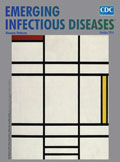
Severe infections are emerging as major risk factors for death among children with juvenile idiopathic arthritis (JIA). In particular, children with refractory JIA treated with long-term, multiple, and often combined immunosuppressive and antiinflammatory agents, including the new biological disease-modifying antirheumatic drugs (DMARDs), are at increased risk for severe infections and death. We investigated 4 persons with JIA who died during 1994–2013, three of overwhelming central venous catheter–related bacterial sepsis caused by coagulase-negative Staphylococus or α-hemolytic Streptococcus infection and 1 of disseminated adenovirus and Epstein-Barr virus infection). All 4 had active JIA refractory to long-term therapy with multiple and combined conventional and biological DMARDs. Two died while receiving high-dose systemic corticosteroids, methotrexate, and after recent exposure to anti–tumor necrosis factor-α biological DMARDs, and 2 during hematopoietic stem cell transplantation procedure. Reporting all cases of severe infections and especially deaths in these children is of paramount importance for accurate surveillance.
| EID | Abinun M, Lane JP, Wood M, Friswell M, Flood TJ, Foster HE. Infection-Related Death among Persons with Refractory Juvenile Idiopathic Arthritis. Emerg Infect Dis. 2016;22(10):1720-1727. https://doi.org/10.3201/eid2210.151245 |
|---|---|
| AMA | Abinun M, Lane JP, Wood M, et al. Infection-Related Death among Persons with Refractory Juvenile Idiopathic Arthritis. Emerging Infectious Diseases. 2016;22(10):1720-1727. doi:10.3201/eid2210.151245. |
| APA | Abinun, M., Lane, J. P., Wood, M., Friswell, M., Flood, T. J., & Foster, H. E. (2016). Infection-Related Death among Persons with Refractory Juvenile Idiopathic Arthritis. Emerging Infectious Diseases, 22(10), 1720-1727. https://doi.org/10.3201/eid2210.151245. |
Little is known about potentially modifiable factors in Ebola virus disease in children. We undertook a retrospective cohort study of children <13 years old admitted to 11 Ebola holding units in the Western Area, Sierra Leone, during 2014–2015 to identify factors affecting outcome. Primary outcome was death or discharge after transfer to Ebola treatment centers. All 309 Ebola virus–positive children 2 days–12 years old were included; outcomes were available for 282 (91%). Case-fatality was 57%, and 55% of deaths occurred in Ebola holding units. Blood test results showed hypoglycemia and hepatic/renal dysfunction. Death occurred swiftly (median 3 days after admission) and was associated with younger age and diarrhea. Despite triangulation of information from multiple sources, data availability was limited, and we identified no modifiable factors substantially affecting death. In future Ebola virus disease epidemics, robust, rapid data collection is vital to determine effectiveness of interventions for children.
| EID | Fitzgerald F, Naveed A, Wing K, Gbessay M, Ross J, Checchi F, et al. Ebola Virus Disease in Children, Sierra Leone, 2014–2015. Emerg Infect Dis. 2016;22(10):1769-1777. https://doi.org/10.3201/eid2210.160579 |
|---|---|
| AMA | Fitzgerald F, Naveed A, Wing K, et al. Ebola Virus Disease in Children, Sierra Leone, 2014–2015. Emerging Infectious Diseases. 2016;22(10):1769-1777. doi:10.3201/eid2210.160579. |
| APA | Fitzgerald, F., Naveed, A., Wing, K., Gbessay, M., Ross, J., Checchi, F....Yeung, S. (2016). Ebola Virus Disease in Children, Sierra Leone, 2014–2015. Emerging Infectious Diseases, 22(10), 1769-1777. https://doi.org/10.3201/eid2210.160579. |
Volume 22, Number 9—September 2016
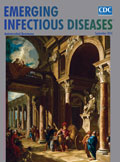
We analyzed data for a retrospective cohort of patients treated for extensively drug-resistant tuberculosis in 2 provinces in South Africa and compared predictors of treatment outcome in HIV-positive patients who received or had not received antiretroviral drugs with those for HIV-negative patients. Overall, 220 (62.0%) of 355 patients were HIV positive. After 2 years, 34 (10.3%) of 330 patients with a known HIV status and known outcome had a favorable outcome. Multivariate analysis showed that predictors of favorable outcome were negative results for acid-fast bacilli by sputum microscopy at start of treatment and weight >50 kg. HIV-positive patients were more likely to have an unfavorable outcome. The strongest predictor of unfavorable outcome was weight <50 kg. Overall outcomes were poor. HIV status was not a predictor of favorable outcome, but HIV-positive patients were more likely to have an unfavorable outcome. These results underscore the need for timely and adequate treatment for tuberculosis and HIV infection.
| EID | Kvasnovsky CL, Cegielski J, van der Walt ML. Treatment Outcomes for Patients with Extensively Drug-Resistant Tuberculosis, KwaZulu-Natal and Eastern Cape Provinces, South Africa. Emerg Infect Dis. 2016;22(9):1529-1536. https://doi.org/10.3201/eid2209.160084 |
|---|---|
| AMA | Kvasnovsky CL, Cegielski J, van der Walt ML. Treatment Outcomes for Patients with Extensively Drug-Resistant Tuberculosis, KwaZulu-Natal and Eastern Cape Provinces, South Africa. Emerging Infectious Diseases. 2016;22(9):1529-1536. doi:10.3201/eid2209.160084. |
| APA | Kvasnovsky, C. L., Cegielski, J., & van der Walt, M. L. (2016). Treatment Outcomes for Patients with Extensively Drug-Resistant Tuberculosis, KwaZulu-Natal and Eastern Cape Provinces, South Africa. Emerging Infectious Diseases, 22(9), 1529-1536. https://doi.org/10.3201/eid2209.160084. |
In the United States, the most commonly diagnosed arboviral disease is West Nile virus (WNV) infection. Diagnosis is made by detecting WNV IgG or viral genomic sequences in serum or cerebrospinal fluid. To determine frequency of this testing in WNV-endemic areas, we examined the proportion of tests ordered for patients with meningitis and encephalitis at 9 hospitals in Houston, Texas, USA. We identified 751 patients (567 adults, 184 children), among whom 390 (52%) experienced illness onset during WNV season (June–October). WNV testing was ordered for 281 (37%) of the 751; results indicated acute infection for 32 (11%). Characteristics associated with WNV testing were acute focal neurologic deficits; older age; magnetic resonance imaging; empirically prescribed antiviral therapy; worse clinical outcomes: and concomitant testing for mycobacterial, fungal, or other viral infections. Testing for WNV is underutilized, and testing of patients with more severe disease raises the possibility of diagnostic bias in epidemiologic studies.
| EID | Vanichanan J, Salazar L, Wootton SH, Aguilera E, Garcia MN, Murray KO, et al. Use of Testing for West Nile Virus and Other Arboviruses. Emerg Infect Dis. 2016;22(9):1587-1593. https://doi.org/10.3201/eid2209.152050 |
|---|---|
| AMA | Vanichanan J, Salazar L, Wootton SH, et al. Use of Testing for West Nile Virus and Other Arboviruses. Emerging Infectious Diseases. 2016;22(9):1587-1593. doi:10.3201/eid2209.152050. |
| APA | Vanichanan, J., Salazar, L., Wootton, S. H., Aguilera, E., Garcia, M. N., Murray, K. O....Hasbun, R. (2016). Use of Testing for West Nile Virus and Other Arboviruses. Emerging Infectious Diseases, 22(9), 1587-1593. https://doi.org/10.3201/eid2209.152050. |
For 2013–2014, we prospectively identified US adults with flank pain, temperature >38.0°C, and a diagnosis of acute pyelonephritis, confirmed by culture. Cultures from 453 (86.9%) of 521 patients grew Escherichia coli. Among E. coli isolates from 272 patients with uncomplicated pyelonephritis and 181 with complicated pyelonephritis, prevalence of fluoroquinolone resistance across study sites was 6.3% (range by site 0.0%–23.1%) and 19.9% (0.0%–50.0%), respectively; prevalence of extended-spectrum β-lactamase (ESBL) production was 2.6% (0.0%–8.3%) and 12.2% (0.0%–17.2%), respectively. Ten (34.5%) of 29 patients with ESBL infection reported no exposure to antimicrobial drugs, healthcare, or travel. Of the 29 patients with ESBL infection and 53 with fluoroquinolone-resistant infection, 22 (75.9%) and 24 (45.3%), respectively, were initially treated with in vitro inactive antimicrobial drugs. Prevalence of fluoroquinolone resistance exceeds treatment guideline thresholds for alternative antimicrobial drug strategies, and community-acquired ESBL-producing E. coli infection has emerged in some US communities.
| EID | Talan DA, Takhar SS, Krishnadasan A, Abrahamian FM, Mower WR, Moran GJ. Fluoroquinolone-Resistant and Extended-Spectrum β-Lactamase–Producing Escherichia coli Infections in Patients with Pyelonephritis, United States. Emerg Infect Dis. 2016;22(9):1594-1603. https://doi.org/10.3201/eid2209.160148 |
|---|---|
| AMA | Talan DA, Takhar SS, Krishnadasan A, et al. Fluoroquinolone-Resistant and Extended-Spectrum β-Lactamase–Producing Escherichia coli Infections in Patients with Pyelonephritis, United States. Emerging Infectious Diseases. 2016;22(9):1594-1603. doi:10.3201/eid2209.160148. |
| APA | Talan, D. A., Takhar, S. S., Krishnadasan, A., Abrahamian, F. M., Mower, W. R., & Moran, G. J. (2016). Fluoroquinolone-Resistant and Extended-Spectrum β-Lactamase–Producing Escherichia coli Infections in Patients with Pyelonephritis, United States. Emerging Infectious Diseases, 22(9), 1594-1603. https://doi.org/10.3201/eid2209.160148. |
Volume 22, Number 8—August 2016
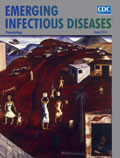
Melioidosis usually occurs after environmental exposure to Burkholderia pseudomallei in the tropics. A cluster of 5 cutaneous melioidosis cases occurred in suburban southwest Australia after an earlier case in January 2012. We collected environmental samples at the first patient’s home in January 2012 and from a nearby health center in December 2013 after 2 new cases occurred in the same postal district. We isolated genotypically identical B. pseudomallei from the first patient and 5 other patients in the district. Environmental sampling implicated an opened bottle of saline wound irrigation fluid containing >106 B. pseudomallei/mL. The bottle included instructions to discard within 24 hours of opening. No further cases of B. pseudomallei infection occurred after removing the contaminated bottle. This cutaneous melioidosis cluster demonstrates that B. pseudomallei can survive and disseminate in widely used medical fluids beyond its known geographic distribution, highlighting a need to use these products according to manufacturers’ instructions.
| EID | Merritt AJ, Peck M, Gayle D, Levy A, Ler Y, Raby E, et al. Cutaneous Melioidosis Cluster Caused by Contaminated Wound Irrigation Fluid. Emerg Infect Dis. 2016;22(8):1420-1427. https://doi.org/10.3201/eid2208.151149 |
|---|---|
| AMA | Merritt AJ, Peck M, Gayle D, et al. Cutaneous Melioidosis Cluster Caused by Contaminated Wound Irrigation Fluid. Emerging Infectious Diseases. 2016;22(8):1420-1427. doi:10.3201/eid2208.151149. |
| APA | Merritt, A. J., Peck, M., Gayle, D., Levy, A., Ler, Y., Raby, E....Inglis, T. (2016). Cutaneous Melioidosis Cluster Caused by Contaminated Wound Irrigation Fluid. Emerging Infectious Diseases, 22(8), 1420-1427. https://doi.org/10.3201/eid2208.151149. |
Volume 22, Number 7—July 2016
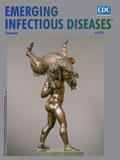
Many of the survivors of the 2014–2015 epidemic of Ebola virus disease (EVD) in West Africa were women of childbearing age. Limited clinical and laboratory data exist that describe these women’s pregnancies and outcomes. We report the case of an EVD survivor who became pregnant and delivered her child in the United States, and we discuss implications of this case for infection control practices in obstetric services. Hospitals in the United States must be prepared to care for EVD survivors.
| EID | Kamali A, Jamieson DJ, Kpaduwa J, Schrier S, Kim M, Green NM, et al. Pregnancy, Labor, and Delivery after Ebola Virus Disease and Implications for Infection Control in Obstetric Services, United States. Emerg Infect Dis. 2016;22(7):1156-1161. https://doi.org/10.3201/eid2207.160269 |
|---|---|
| AMA | Kamali A, Jamieson DJ, Kpaduwa J, et al. Pregnancy, Labor, and Delivery after Ebola Virus Disease and Implications for Infection Control in Obstetric Services, United States. Emerging Infectious Diseases. 2016;22(7):1156-1161. doi:10.3201/eid2207.160269. |
| APA | Kamali, A., Jamieson, D. J., Kpaduwa, J., Schrier, S., Kim, M., Green, N. M....Mascola, L. (2016). Pregnancy, Labor, and Delivery after Ebola Virus Disease and Implications for Infection Control in Obstetric Services, United States. Emerging Infectious Diseases, 22(7), 1156-1161. https://doi.org/10.3201/eid2207.160269. |
In the United States, Lyme disease is caused by Borrelia burgdorferi and transmitted to humans by blacklegged ticks. Patients with an erythema migrans lesion and epidemiologic risk can receive a diagnosis without laboratory testing. For all other patients, laboratory testing is necessary to confirm the diagnosis, but proper interpretation depends on symptoms and timing of illness. The recommended laboratory test in the United States is 2-tiered serologic analysis consisting of an enzyme-linked immunoassay or immunofluorescence assay, followed by reflexive immunoblotting. Sensitivity of 2-tiered testing is low (30%–40%) during early infection while the antibody response is developing (window period). For disseminated Lyme disease, sensitivity is 70%–100%. Specificity is high (>95%) during all stages of disease. Use of other diagnostic tests for Lyme disease is limited. We review the rationale behind current US testing guidelines, appropriate use and interpretation of tests, and recent developments in Lyme disease diagnostics.
| EID | Moore A, Nelson CA, Molins C, Mead PS, Schriefer M. Current Guidelines, Common Clinical Pitfalls, and Future Directions for Laboratory Diagnosis of Lyme Disease, United States. Emerg Infect Dis. 2016;22(7):1169-1177. https://doi.org/10.3201/eid2207.151694 |
|---|---|
| AMA | Moore A, Nelson CA, Molins C, et al. Current Guidelines, Common Clinical Pitfalls, and Future Directions for Laboratory Diagnosis of Lyme Disease, United States. Emerging Infectious Diseases. 2016;22(7):1169-1177. doi:10.3201/eid2207.151694. |
| APA | Moore, A., Nelson, C. A., Molins, C., Mead, P. S., & Schriefer, M. (2016). Current Guidelines, Common Clinical Pitfalls, and Future Directions for Laboratory Diagnosis of Lyme Disease, United States. Emerging Infectious Diseases, 22(7), 1169-1177. https://doi.org/10.3201/eid2207.151694. |
Volume 22, Number 6—June 2016
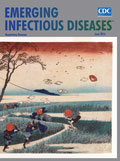
Since March 2013, a novel influenza A(H7N9) virus has caused 3 epidemic waves of human infection in mainland China. We analyzed data from patients with laboratory-confirmed influenza A(H7N9) virus infection to estimate the risks for severe outcomes after hospitalization across the 3 waves. We found that hospitalized patients with confirmed infections in waves 2 and 3 were younger and more likely to be residing in small cities and rural areas than were patients in wave 1; they also had a higher risk for death, after adjustment for age and underlying medical conditions. Risk for death among hospitalized patients during waves 2 and 3 was lower in Jiangxi and Fujian Provinces than in eastern and southern provinces. The variation in risk for death among hospitalized case-patients in different areas across 3 epidemic waves might be associated with differences in case ascertainment, changes in clinical management, or virus genetic diversity.
| EID | Wu P, Peng Z, Fang VJ, Feng L, Tsang TK, Jiang H, et al. Human Infection with Influenza A(H7N9) Virus during 3 Major Epidemic Waves, China, 2013–2015. Emerg Infect Dis. 2016;22(6):964-972. https://doi.org/10.3201/eid2206.151752 |
|---|---|
| AMA | Wu P, Peng Z, Fang VJ, et al. Human Infection with Influenza A(H7N9) Virus during 3 Major Epidemic Waves, China, 2013–2015. Emerging Infectious Diseases. 2016;22(6):964-972. doi:10.3201/eid2206.151752. |
| APA | Wu, P., Peng, Z., Fang, V. J., Feng, L., Tsang, T. K., Jiang, H....Cowling, B. J. (2016). Human Infection with Influenza A(H7N9) Virus during 3 Major Epidemic Waves, China, 2013–2015. Emerging Infectious Diseases, 22(6), 964-972. https://doi.org/10.3201/eid2206.151752. |
Administration of propofol, the most frequently used intravenous anesthetic worldwide, has been associated with several iatrogenic infections despite its relative safety. Little is known regarding the global epidemiology of propofol-related outbreaks and the effectiveness of existing preventive strategies. In this overview of the evidence of propofol as a source of infection and appraisal of preventive strategies, we identified 58 studies through a literature search in PubMed, Embase, and Lilacs for propofol-related infections during 1989–2014. Twenty propofol-related outbreaks have been reported, affecting 144 patients and resulting in 10 deaths. Related factors included reuse of syringes for multiple patients and prolonged exposure to the environment when vials were left open. The addition of antimicrobial drugs to the emulsion has been instituted in some countries, but outbreaks have still occurred. There remains a lack of comprehensive information on the effectiveness of measures to prevent future outbreaks.
| EID | Zorrilla-Vaca A, Arevalo JJ, Escandón-Vargas K, Soltanifar D, Mirski MA. Infectious Disease Risk Associated with Contaminated Propofol Anesthesia, 1989–2014. Emerg Infect Dis. 2016;22(6):981-992. https://doi.org/10.3201/eid2206.150376 |
|---|---|
| AMA | Zorrilla-Vaca A, Arevalo JJ, Escandón-Vargas K, et al. Infectious Disease Risk Associated with Contaminated Propofol Anesthesia, 1989–2014. Emerging Infectious Diseases. 2016;22(6):981-992. doi:10.3201/eid2206.150376. |
| APA | Zorrilla-Vaca, A., Arevalo, J. J., Escandón-Vargas, K., Soltanifar, D., & Mirski, M. A. (2016). Infectious Disease Risk Associated with Contaminated Propofol Anesthesia, 1989–2014. Emerging Infectious Diseases, 22(6), 981-992. https://doi.org/10.3201/eid2206.150376. |
Volume 22, Number 5—May 2016

In the United States, all previously reported cases of Rickettsia parkeri rickettsiosis have been linked to transmission by the Gulf Coast tick (Amblyomma maculatum). Here we describe 1 confirmed and 1 probable case of R. parkeri rickettsiosis acquired in a mountainous region of southern Arizona, well beyond the recognized geographic range of A. maculatum ticks. The likely vector for these 2 infections was identified as the Amblyomma triste tick, a Neotropical species only recently recognized in the United States. Identification of R. parkeri rickettsiosis in southern Arizona demonstrates a need for local ecologic and epidemiologic assessments to better understand geographic distribution and define public health risk. Education and outreach aimed at persons recreating or working in this region of southern Arizona would improve awareness and promote prevention of tickborne rickettsioses.
| EID | Herrick KL, Pena SA, Yaglom H, Layton BJ, Moors A, Loftis AD, et al. Rickettsia parkeri Rickettsiosis, Arizona, USA. Emerg Infect Dis. 2016;22(5):780-785. https://doi.org/10.3201/eid2205.151824 |
|---|---|
| AMA | Herrick KL, Pena SA, Yaglom H, et al. Rickettsia parkeri Rickettsiosis, Arizona, USA. Emerging Infectious Diseases. 2016;22(5):780-785. doi:10.3201/eid2205.151824. |
| APA | Herrick, K. L., Pena, S. A., Yaglom, H., Layton, B. J., Moors, A., Loftis, A. D....Paddock, C. D. (2016). Rickettsia parkeri Rickettsiosis, Arizona, USA. Emerging Infectious Diseases, 22(5), 780-785. https://doi.org/10.3201/eid2205.151824. |
Malaria is the most common specific cause of fever in returning travelers, but many other vectorborne infections and viral infections are emerging and increasingly encountered by travelers. We documented common and emerging viral pathogens in malaria-negative specimens from ill travelers returning to Canada. Anonymized, malaria-negative specimens were examined for various viral pathogens by real-time PCR. Samples were positive for herpes simplex viruses 1 or 2 (n = 21, 1.6%), cytomegalovirus (n = 4, 0.3%), Epstein-Barr virus (n = 194, 14.9%), dengue virus types 1–4 (n = 27, 2.1%), chikungunya virus (n = 5, 0.4%), and hepatitis A virus (n = 12, 0.9%). Travel-acquired viral pathogens were documented in >20% of malaria-negative specimens, of which 2.5% were infected with dengue and chikungunya viruses. Our findings support the anecdotal impression that these vectorborne pathogens are emerging among persons who travel from Canada to other countries.
| EID | Kariyawasam R, Lau R, Eshaghi A, Patel SN, Sider D, Gubbay JB, et al. Spectrum of Viral Pathogens in Blood of Malaria-Free Ill Travelers Returning to Canada. Emerg Infect Dis. 2016;22(5):854-861. https://doi.org/10.3201/eid2205.151875 |
|---|---|
| AMA | Kariyawasam R, Lau R, Eshaghi A, et al. Spectrum of Viral Pathogens in Blood of Malaria-Free Ill Travelers Returning to Canada. Emerging Infectious Diseases. 2016;22(5):854-861. doi:10.3201/eid2205.151875. |
| APA | Kariyawasam, R., Lau, R., Eshaghi, A., Patel, S. N., Sider, D., Gubbay, J. B....Boggild, A. K. (2016). Spectrum of Viral Pathogens in Blood of Malaria-Free Ill Travelers Returning to Canada. Emerging Infectious Diseases, 22(5), 854-861. https://doi.org/10.3201/eid2205.151875. |
Volume 22, Number 4—April 2016
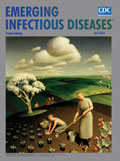
Shiga toxins (Stx) are primarily associated with Shiga toxin–producing Escherichia coli and Shigella dysenteriae serotype 1. Stx production by other shigellae is uncommon, but in 2014, Stx1-producing S. sonnei infections were detected in California. Surveillance was enhanced to test S. sonnei isolates for the presence and expression of stx genes, perform DNA subtyping, describe clinical and epidemiologic characteristics of case-patients, and investigate for sources of infection. During June 2014–April 2015, we identified 56 cases of Stx1-producing S. sonnei, in 2 clusters. All isolates encoded stx1 and produced active Stx1. Multiple pulsed-field gel electrophoresis patterns were identified. Bloody diarrhea was reported by 71% of case-patients; none had hemolytic uremic syndrome. Some initial cases were epidemiologically linked to travel to Mexico, but subsequent infections were transmitted domestically. Continued surveillance of Stx1-producing S. sonnei in California is necessary to characterize its features and plan for reduction of its spread in the United States.
| EID | Lamba K, Nelson JA, Kimura AC, Poe A, Collins J, Kao AS, et al. Shiga Toxin 1–Producing Shigella sonnei Infections, California, United States, 2014–2015. Emerg Infect Dis. 2016;22(4):679-686. https://doi.org/10.3201/eid2204.151825 |
|---|---|
| AMA | Lamba K, Nelson JA, Kimura AC, et al. Shiga Toxin 1–Producing Shigella sonnei Infections, California, United States, 2014–2015. Emerging Infectious Diseases. 2016;22(4):679-686. doi:10.3201/eid2204.151825. |
| APA | Lamba, K., Nelson, J. A., Kimura, A. C., Poe, A., Collins, J., Kao, A. S....Vugia, D. (2016). Shiga Toxin 1–Producing Shigella sonnei Infections, California, United States, 2014–2015. Emerging Infectious Diseases, 22(4), 679-686. https://doi.org/10.3201/eid2204.151825. |
Volume 22, Number 3—March 2016
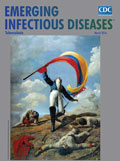
Histoplasmosis has been described as the most common endemic mycosis in the United States. However, histoplasmosis is not nationally notifiable. Its presumed geographic distribution is largely derived from skin test surveys performed during the 1940s, and information about its local features comes primarily from outbreak investigations. We conducted a literature review to assess epidemiologic features of histoplasmosis outbreaks in the United States. During 1938–2013, a total of 105 outbreaks involving 2,850 cases were reported in 26 states and the territory of Puerto Rico. Common exposure settings were chicken coops and buildings or other structures undergoing renovation or demolition. Birds, bats, or their droppings were reported to be present in 77% of outbreak settings, and workplace exposures were reported in 41% of outbreaks. The continued occurrence of histoplasmosis outbreaks, particularly work-related ones involving known disturbance of bird or bat droppings, highlights the need to increase awareness of the disease.
| EID | Benedict K, Mody RK. Epidemiology of Histoplasmosis Outbreaks, United States, 1938–2013. Emerg Infect Dis. 2016;22(3):370-378. https://doi.org/10.3201/eid2203.151117 |
|---|---|
| AMA | Benedict K, Mody RK. Epidemiology of Histoplasmosis Outbreaks, United States, 1938–2013. Emerging Infectious Diseases. 2016;22(3):370-378. doi:10.3201/eid2203.151117. |
| APA | Benedict, K., & Mody, R. K. (2016). Epidemiology of Histoplasmosis Outbreaks, United States, 1938–2013. Emerging Infectious Diseases, 22(3), 370-378. https://doi.org/10.3201/eid2203.151117. |
Mycobacterial infections resulting from cardiac implantable electronic devices are rare, but as more devices are implanted, these organisms are increasingly emerging as causes of early-onset infections. We report a patient with an implantable cardioverter-defibrillator pocket and associated bloodstream infection caused by an organism of the Mycobacterium fortuitum group, and we review the literature regarding mycobacterial infections resulting from cardiac device implantations. Thirty-two such infections have been previously described; most (70%) were caused by rapidly growing species, of which M. fortuitum group species were predominant. When managing such infections, clinicians should consider the potential need for extended incubation of routine cultures or dedicated mycobacterial cultures for accurate diagnosis; combination antimicrobial drug therapy, even for isolates that appear to be macrolide susceptible, because of the potential for inducible resistance to this drug class; and the arrhythmogenicity of the antimicrobial drugs traditionally recommended for infections caused by these organisms.
| EID | Phadke VK, Hirsh DS, Goswami ND. Patient Report and Review of Rapidly Growing Mycobacterial Infection after Cardiac Device Implantation. Emerg Infect Dis. 2016;22(3):389-395. https://doi.org/10.3201/eid2203.150584 |
|---|---|
| AMA | Phadke VK, Hirsh DS, Goswami ND. Patient Report and Review of Rapidly Growing Mycobacterial Infection after Cardiac Device Implantation. Emerging Infectious Diseases. 2016;22(3):389-395. doi:10.3201/eid2203.150584. |
| APA | Phadke, V. K., Hirsh, D. S., & Goswami, N. D. (2016). Patient Report and Review of Rapidly Growing Mycobacterial Infection after Cardiac Device Implantation. Emerging Infectious Diseases, 22(3), 389-395. https://doi.org/10.3201/eid2203.150584. |
Mycobacterium africanum is endemic to West Africa and causes tuberculosis (TB). We reviewed reported cases of TB in the United States during 2004–2013 that had lineage assigned by genotype (spoligotype and mycobacterial interspersed repetitive unit variable number tandem repeats). M. africanum caused 315 (0.4%) of 73,290 TB cases with lineage assigned by genotype. TB caused by M. africanum was associated more with persons from West Africa (adjusted odds ratio [aOR] 253.8, 95% CI 59.9–1,076.1) and US-born black persons (aOR 5.7, 95% CI 1.2–25.9) than with US-born white persons. TB caused by M. africanum did not show differences in clinical characteristics when compared with TB caused by M. tuberculosis. Clustered cases defined as >2 cases in a county with identical 24-locus mycobacterial interspersed repetitive unit genotypes, were less likely for M. africanum (aOR 0.1, 95% CI 0.1–0.4), which suggests that M. africanum is not commonly transmitted in the United States.
| EID | Sharma A, Bloss E, Heilig CM, Click ES. Tuberculosis Caused by Mycobacterium africanum, United States, 2004–2013. Emerg Infect Dis. 2016;22(3):396-403. https://doi.org/10.3201/eid2203.151505 |
|---|---|
| AMA | Sharma A, Bloss E, Heilig CM, et al. Tuberculosis Caused by Mycobacterium africanum, United States, 2004–2013. Emerging Infectious Diseases. 2016;22(3):396-403. doi:10.3201/eid2203.151505. |
| APA | Sharma, A., Bloss, E., Heilig, C. M., & Click, E. S. (2016). Tuberculosis Caused by Mycobacterium africanum, United States, 2004–2013. Emerging Infectious Diseases, 22(3), 396-403. https://doi.org/10.3201/eid2203.151505. |
Volume 22, Number 2—February 2016

In September 2013, local county health officials in Tallahassee, Florida, USA, were notified of a laboratory-confirmed pertussis case in a 1-year-old preschool attendee. During a 5-month period, 26 (22%) students 1–5 years of age, 2 staff from the same preschool, and 11 family members met the national case definition for pertussis. Four persons during this outbreak were hospitalized for clinical management of pertussis symptoms. Only 5 students, including 2 students with pertussis, had not received the complete series of vaccinations for pertussis. Attack rates in 1 classroom for all students who received the complete series of vaccinations for pertussis approached 50%. This outbreak raises concerns about vaccine effectiveness in this preschool age group and reinforces the idea that recent pertussis vaccination should not dissuade physicians from diagnosing, testing, or treating persons with compatible illness for pertussis.
| EID | Matthias J, Pritchard P, Martin SW, Dusek C, Cathey E, D’Alessio R, et al. Sustained Transmission of Pertussis in Vaccinated, 1–5-Year-Old Children in a Preschool, Florida, USA. Emerg Infect Dis. 2016;22(2):242-246. https://doi.org/10.3201/eid2202.150325 |
|---|---|
| AMA | Matthias J, Pritchard P, Martin SW, et al. Sustained Transmission of Pertussis in Vaccinated, 1–5-Year-Old Children in a Preschool, Florida, USA. Emerging Infectious Diseases. 2016;22(2):242-246. doi:10.3201/eid2202.150325. |
| APA | Matthias, J., Pritchard, P., Martin, S. W., Dusek, C., Cathey, E., D’Alessio, R....Kirsch, M. (2016). Sustained Transmission of Pertussis in Vaccinated, 1–5-Year-Old Children in a Preschool, Florida, USA. Emerging Infectious Diseases, 22(2), 242-246. https://doi.org/10.3201/eid2202.150325. |
We collected β-hemolytic streptococci (1,611 isolates) from patients with invasive streptococcal infections in Japan during April 2010–March 2013. Streptococcus dysgalactiae subsp. equisimilis (SDSE) was most common (n = 693); 99% of patients with SDSE infections were elderly (mean age 75 years, SD ±15 years). We aimed to clarify molecular and epidemiologic characteristics of SDSE isolates and features of patient infections. Bacteremia with no identified focus of origin and cellulitis were the most prevalent manifestations; otherwise, clinical manifestations resembled those of S. pyogenes infections. Clinical manifestations also differed by patient’s age. SDSE isolates were classified into 34 emm types; stG6792 was most prevalent (27.1%), followed by stG485 and stG245. Mortality rates did not differ according to emm types. Multilocus sequence typing identified 46 sequence types and 12 novel types. Types possessing macrolide- and quinolone-resistance genes were 18.4% and 2.6%, respectively; none showed β-lactam resistance. Among aging populations, invasive SDSE infections are an increasing risk.
| EID | Wajima T, Morozumi M, Hanada S, Sunaoshi K, Chiba N, Iwata S, et al. Molecular Characterization of Invasive Streptococcus dysgalactiae subsp. equisimilis, Japan. Emerg Infect Dis. 2016;22(2):247-254. https://doi.org/10.3201/eid2202.141732 |
|---|---|
| AMA | Wajima T, Morozumi M, Hanada S, et al. Molecular Characterization of Invasive Streptococcus dysgalactiae subsp. equisimilis, Japan. Emerging Infectious Diseases. 2016;22(2):247-254. doi:10.3201/eid2202.141732. |
| APA | Wajima, T., Morozumi, M., Hanada, S., Sunaoshi, K., Chiba, N., Iwata, S....Ubukata, K. (2016). Molecular Characterization of Invasive Streptococcus dysgalactiae subsp. equisimilis, Japan. Emerging Infectious Diseases, 22(2), 247-254. https://doi.org/10.3201/eid2202.141732. |
Volume 22, Number 1—January 2016

The global epidemiology of Haemophilus ducreyi infections is poorly documented because of difficulties in confirming microbiological diagnoses. We evaluated published data on the proportion of genital and nongenital skin ulcers caused by H. ducreyi before and after introduction of syndromic management for genital ulcer disease (GUD). Before 2000, the proportion of GUD caused by H. ducreyi ranged from 0.0% to 69.0% (35 studies in 25 countries). After 2000, the proportion ranged from 0.0% to 15.0% (14 studies in 13 countries). In contrast, H. ducreyi has been recently identified as a causative agent of skin ulcers in children in the tropical regions; proportions ranged from 9.0% to 60.0% (6 studies in 4 countries). We conclude that, although there has been a sustained reduction in the proportion of GUD caused by H. ducreyi, this bacterium is increasingly recognized as a major cause of nongenital cutaneous ulcers.
| EID | González-Beiras C, Marks M, Chen CY, Roberts S, Mitjà O. Epidemiology of Haemophilus ducreyi Infections. Emerg Infect Dis. 2016;22(1):1-8. https://doi.org/10.3201/eid2201.150425 |
|---|---|
| AMA | González-Beiras C, Marks M, Chen CY, et al. Epidemiology of Haemophilus ducreyi Infections. Emerging Infectious Diseases. 2016;22(1):1-8. doi:10.3201/eid2201.150425. |
| APA | González-Beiras, C., Marks, M., Chen, C. Y., Roberts, S., & Mitjà, O. (2016). Epidemiology of Haemophilus ducreyi Infections. Emerging Infectious Diseases, 22(1), 1-8. https://doi.org/10.3201/eid2201.150425. |
Deaths from Plasmodium knowlesi malaria have been linked to delayed parenteral treatment. In Malaysia, early intravenous artesunate is now recommended for all severe malaria cases. We describe P. knowlesi fatalities in Sabah, Malaysia, during 2012–2014 and report species-specific fatality rates based on 2010–2014 case notifications. Sixteen malaria-associated deaths (caused by PCR-confirmed P. knowlesi [7], P. falciparum [7], and P. vivax [1] and microscopy-diagnosed “P. malariae” [1]) were reported during 2012–2014. Six patients with severe P. knowlesi malaria received intravenous artesunate at hospital admission. For persons >15 years of age, overall fatality rates during 2010–2014 were 3.4, 4.2, and 1.0 deaths/1,000 P. knowlesi, P. falciparum, and P. vivax notifications, respectively; P. knowlesi–associated fatality rates fell from 9.2 to1.6 deaths/1,000 notifications. No P. knowlesi–associated deaths occurred among children, despite 373 notified cases. Although P. knowlesi malaria incidence is rising, the notification-fatality rate has decreased, likely due to improved use of intravenous artesunate.
| EID | Rajahram GS, Barber BE, William T, Grigg MJ, Menon J, Yeo TW, et al. Falling Plasmodium knowlesi Malaria Death Rate among Adults despite Rising Incidence, Sabah, Malaysia, 2010–2014. Emerg Infect Dis. 2016;22(1):41-48. https://doi.org/10.3201/eid2201.151305 |
|---|---|
| AMA | Rajahram GS, Barber BE, William T, et al. Falling Plasmodium knowlesi Malaria Death Rate among Adults despite Rising Incidence, Sabah, Malaysia, 2010–2014. Emerging Infectious Diseases. 2016;22(1):41-48. doi:10.3201/eid2201.151305. |
| APA | Rajahram, G. S., Barber, B. E., William, T., Grigg, M. J., Menon, J., Yeo, T. W....Anstey, N. M. (2016). Falling Plasmodium knowlesi Malaria Death Rate among Adults despite Rising Incidence, Sabah, Malaysia, 2010–2014. Emerging Infectious Diseases, 22(1), 41-48. https://doi.org/10.3201/eid2201.151305. |
CME Articles by Volume




